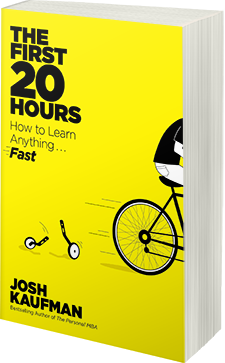
By Josh Kaufman,
$26.95, Portfolio / Penguin
Released June 13, 2013
Chances are you have a laundry list of things you want to learn and do, but little time to do them. Josh Kaufman, a self-described "learning addict," and author of The Personal MBA has an idea to help: What could you learn if you invested just 20 hours of time in acquiring a new skill?
Kaufman does this by setting aside the time for learning six new things in an experiment he describes in his new book The First 20 Hours. He chronicles his experiences learning yoga poses, computer programming, windsurfing, the ancient Chinese board game "Go," touch typing, and even playing the ukulele.
This goes against the 10,000 hours of practice rule--the subject of Malcolm Gladwell's 2011 bestselling book Outliers--as the minimum amount of time needed for the mastery of any subject. The rule has recently become conventional wisdom spread by speakers of TED talks, public intellectuals, and even hip hop artist Macklemore.
But if you're a busy professional, how in the world do you find time to spend 10,000 hours learning something? Who can even find that amount of time?
"Ten thousand hours equals eight hours of deliberate practice every day for approximately three and a half years with no breaks, no weekends, and no vacations," Kaufman writes of the rule--which is derived from the research of Dr. K. Anders Ericsson.
If you're not interested in expert level achievement, you can break down learning into a systematic practice of about an hour a day for a little less than a month.
The real challenge behind rapid skill acquisition as Kaufman puts it, is to get past the initial challenge of "beginners mind," which is the frustration that occurs when learning something new doesn't come as naturally as hoped for.
The bulk of the book focuses on the six subjects Kaufman chooses to learn. Learning yoga proves to be an informative and entertaining read, because it appears to have been a more "loveable project," for the author than learning touch typing. Kaufman clearly has more difficulty with learning typing because he is relearning a skill when choosing to replace his knowledge of the typical QWERTY layout by opting for the more efficient Colemak format.
The chapter on Go is particularly fascinating since it seems that learning new games is skill set inherent to our culture. The game of Go is similar to chess, and is particularly suited to individuals interested in how a simple game can prove fascinating enough to inspire one to mastery.
Kaufman finds a shortcut to learning how to play the Ukulele by memorizing the three chords needed for the majority of songs, which happen to be C, F and G.
Kaufman states upfront why he is interested in rapid skill learning: "I don't have very much time, but I'm willing to invest what I have as wisely as possible." That being said, if you follow his advice, you could probably get the gist of the book from reading the first three chapters.
Yet, reading the whole book reveal the nuances of learning something new through trial and error. And Kaufman is a lively narrator to share the experience with. Clearly, some new skills for him stick, and others prove difficult, even after putting hours of time in.
The biggest takeaway of the book is this: Whatever you choose to learn comes down to simply getting out of something what you put into it--whether that time invested is 20 years or just 20 hours.